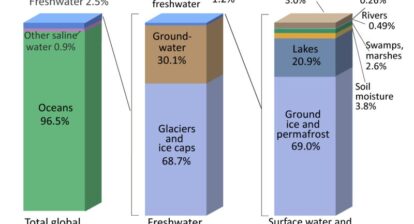Nature once again overturns our perceptions. We generally tend to think of bacteria as tiny micropscopic creatures but in a new study, scientists have identified a bacterium in a Caribbean mangrove swamp, that is actually macroscopic in size. This new species is called Thiomargarita magnifica, meaning “sulfur pearl,” and it looks like a huge thin white filament visible to the naked eye.
“Cells of most bacterial species are around 2 micrometers in length, with some of the largest specimens reaching 750 micrometers. Using fluorescence, x-ray, and electron microscopy in conjunction with genome sequencing, we characterized Candidatus (Ca.) Thiomargarita magnifica, a bacterium that has an average cell length greater than 9000 micrometers and is visible to the naked eye”, say the researchers in the study.
“It’s 5,000 times bigger than most bacteria. To put it into context, it would be like a human encountering another human as tall as Mount Everest,” said Jean-Marie Volland, a scientist with joint appointments at the U.S. Department of Energy (DOE) Joint Genome Institute (JGI), a DOE Office of Science User Facility located at Lawrence Berkeley National Laboratory (Berkeley Lab) and the Laboratory for Research in Complex Systems (LRC) in Menlo Park, Calif.
Describing the morphological and genomic features of the organism the scientists said, “For most bacteria, their DNA floats freely within the cytoplasm of their cells. This newly discovered species of bacteria keeps its DNA more organized. “The big surprise of the project was to realize that these genome copies that are spread throughout the whole cell are actually contained within a structure that has a membrane,” Volland said. “And this is very unexpected for a bacterium.”
The bacterium was discovered by Olivier Gros, a marine biology professor at the Université des Antilles in Guadeloupe, in 2009, who was looking for sulfur-oxidizing symbionts in sulfur-rich mangrove sediments when he first encountered the bacteria. “When I saw them, I thought, ‘Strange,’” he said. “In the beginning I thought it was just something curious, some white filaments that needed to be attached to something in the sediment like a leaf.” When the lab conducted further studies over the next couple of years, they realized it was a sulfur-oxidizing prokaryote.
Silvina Gonzalez-Rizzo, an associate professor of molecular biology at the Université des Antilles and a co-first author on the study, performed the gene sequencing to identify and classify the prokaryote. “I thought they were eukaryotes; I didn’t think they were bacteria because they were so big with seemingly a lot of filaments,” she recalled of her first impression. “We realized they were unique because it looked like a single cell. The fact that they were a ‘macro’ microbe was fascinating!”
“She understood that it was a bacterium belonging to the genus Thiomargarita,” Gros noted. “She named it Ca. Thiomargarita magnifica.”
“Magnifica because magnus in Latin means big and I think it’s gorgeous like the French word magnifique,” Gonzalez-Rizzo explained. “This kind of discovery opens new questions about bacterial morphotypes that have never been studied before.”
Volland used various microscopy techniques, such as hard x-ray tomography, to visualize entire filaments up to 9.66 mm long and “confirmed that they were indeed giant single cells rather than multicellular filaments, as is common in other large sulfur bacteria”.
“The bacteria contain three times more genes than most bacteria and hundreds of thousands of genome copies (polyploidy) that are spread throughout the entire cell”, he noted.
“This project has been a nice opportunity to demonstrate how complexity has evolved in some of the simplest organisms,” said Shailesh Date, founder and CEO of LRC, and one of the article’s senior authors. “One of the things we’ve argued is that there is need to look at and study biological complexity in much more detail than what is being done currently. So organisms that we think are very, very simple might have some surprises.”
The researchers are now considering other questions that have been opened up, such as the bacterium’s role in the mangrove ecosystem “We know that it’s growing and thriving on top of the sediment of mangrove ecosystem in the Caribbean,” Volland said. “In terms of metabolism, it does chemosynthesis, which is a process analogous to photosynthesis for plants.”
Volland also used confocal laser scanning microscopy and transmission electron microscopy (TEM) to visualize the filaments and the cell membranes in more details, which allowed him to observe novel, membrane-bound compartments that contain DNA clusters. He dubbed these organelles “pepins,” after the small seeds in fruits. This led to another question as to whether these new organelles named pepins played a role in the evolution of the bacterium’s large size, and whether or not pepins are present in other bacterial species.
Both Gonzalez-Rizzo and Woyke hope that successfully cultivating the bacteria in the lab would allow them to answer these questions. “If we can maintain these bacteria in a laboratory setting, we can use techniques that are not feasible right now”, Woyke said. Gros wants to look at other large bacteria. “You can find some TEM pictures and see what look like pepins so maybe people saw them but did not understand what they were. That will be very interesting to check, if the pepins are already present everywhere.”







